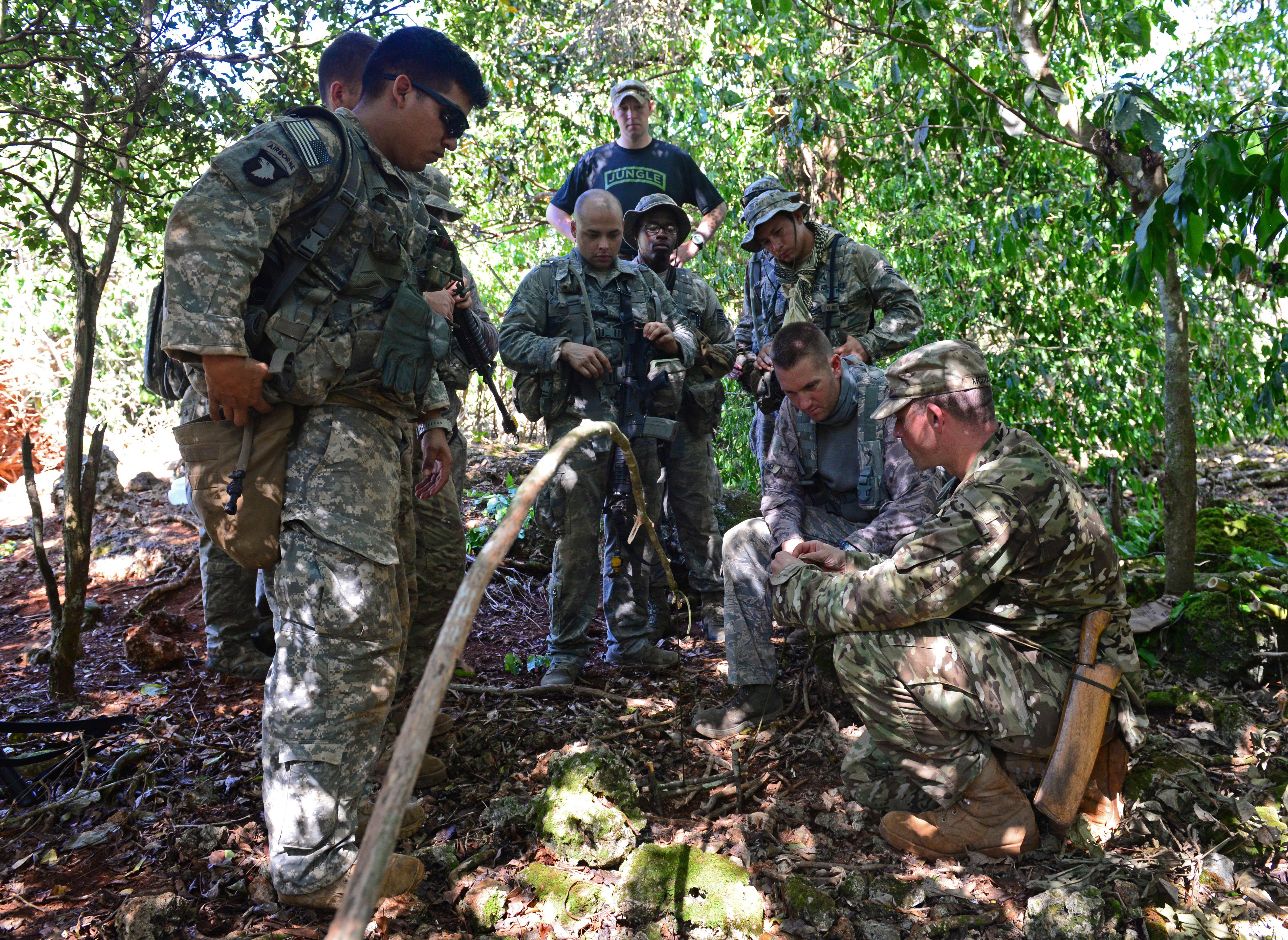Through The Thick Of It: Airmen, Soldiers Tackle Joint Jungle Training
By Senior Airman Joshua Smoot, 36th Wing Public Affairs, Published 30 June 2016
Airmen and Soldiers learn how to set animal traps and snares during the Jungle Training Operations Course June 17, 2016, at Andersen Air Force Base, Guam. From June 15-21, instructors from the U.S. Army 25th Infantry Division’s Lightning Academy Jungle Operations Training Center, in Schofield Barracks, Hawaii, travelled to Guam to teach more than 30 Airmen and Soldiers the fundamentals of fighting and surviving in jungles with support from cadre members of the 736th Security Forces Squadron. (U.S. Air Force photo by Senior Airman Joshua Smoot)
ANDERSEN AIR FORCE BASE, Guam -- Veiled in darkness, two MH-60 Seahawks cut through the humid night air heading toward a landing zone in an abandoned military building complex.
Inside each helicopter, Airmen and Soldiers take deep final breaths attempting to calm their nerves. A crew chief turns his head and then alerts everyone onboard with a booming “30 seconds!” that their drop is coming up.
After checking their weapons and placing their night vision goggles over their eyes, the team prepares for landing. On the ground, their dark silhouettes rush from the aircraft and drop for cover in the tall grass.
Seven days of training prepared the military students for this moment. They are taking part in the final exercise of the Jungle Training Operations Course at Andersen Air Force Base, Guam. From June 15-21, instructors from the U.S. Army 25th Infantry Division’s Lightning Academy Jungle Operations Training Center, at Schofield Barracks, Hawaii, travelled to Guam to teach more than 30 Airmen and Soldiers the fundamentals of fighting and surviving in jungles with support from cadre members of the 736th Security Forces Squadron.
“This jungle operations training is important, because it helps build Department of Defense readiness and service interoperability,” said U.S. Army Staff Sgt. Sydney Hays, JTOC instructor. “The high caliber training is a force multiplier applicable across the U.S. Pacific Command area of operations.”
The idea of hosting the condensed training at Andersen AFB came up when Master Sgt. Jeremy Burkeen, 736th SFS operations superintendent, and the squadron’s director of operations attended the 14-day Jungle Training Operations Course in Hawaii nearly a year ago.
“This training is a lost art,” Burkeen said. “With the push to the Pacific and the threats that lie in the Pacific Rim, we have to get back to the basics of airmanship and soldier skills.”
Guam served as an ideal alternate location to Hawaii with its relatively humid and warm climate and dense vegetation. Besides battling the heat, the students avoided run-ins with the local wildlife including monitor lizards, feral pigs and the infamous boonie bees.
The trainees were individually selected from several career fields across the DOD, including Airmen from the 36th Security Forces Squadron, 736th SFS, 554th RED HORSE Squadron, 644th Combat Communications Squadron and infantrymen from the 94th Army Air and Missile Defense Command’s Task Force Talon. For many of them, this was the first time operating in a jungle environment.
On the first day, participants had to prove they had what it took to make it through the course. The students were tasked with completing an aptly-named two and a half mile terrain appreciation run beginning at Tarague Beach.
“The run measured the motivation levels of the students in attendance,” Burkeen said. “It allowed the cadre to set the pace for the remaining of the training. You hit (it hard) from the get go so they know what to expect throughout the course.”
After devouring their Meals, Ready to Eat, trainees joined the instructors for an introduction to survival and navigation tactics in jungle terrain. The teams learned how to trap and snare animals, how to prepare their food once captured and several ways to purify drinking water.
After hours putting the techniques to practice, Airmen and Soldiers teamed up with U.S. Navy Sailors from the Helicopter Sea Combat Squadron 25 for jungle air-to-ground procedures, medical evacuation training and air assaults.
After the third day of training, fatigue from sleep deprivation began taking a toll as the teams only slept for a few consecutive hours and were challenged to pace their calorie intake to make their once-daily meal rations last, Burkeen said.
With the week drawing to an end, the students faced one final test of their ability to operate in a tropical environment. Arriving via helicopter, the teams set out to locate a hidden weapons cache. After achieving their initial objective, the teams then secured their position and prepared for nightfall.
When dawn arrived, they initiated an ambush on opposing forces and evacuated a simulated casualty by helicopter. Following a successful rescue, the crew received a new mission, tasking them to put their new skills to use in traversing difficult jungle terrain to raid an enemy hideout. As nightfall once again took over, Airmen and Soldiers executed their final ambush before being extracted and vanishing from the training site as fast as they arrived.
The students left the course with an added respect for the environment and each other. By overcoming the same obstacles throughout the course, teams developed a renewed sense of camaraderie between people who normally don’t work in the same units and will be able to share newly-acquired skills with their wingmen.
“This course was more difficult than I anticipated, but I learned that no matter what you go through, you can push through it,” said Staff Sgt. Ryan Dirner, JOTC student from the 736th SFS. “I enjoy this type of training and it is extremely valuable to what we do.”




